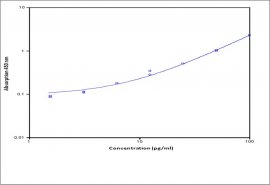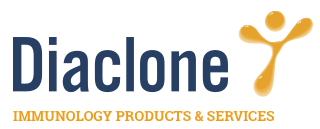Rat IL-17A ELISA kit
Product Specifications
- Catalogue N°
- 670.080.096 - 1 x 96 (pre-coated)
670.080.192 - 2 x 96 (pre-coated) - Assay Range
- 1.6 pg/ml - 100 pg/ml
- Sensitivity
- 1.0pg/ml
- Target species
- Rat
- Specificity
- Recognizes both natural and recombinant rat IL-17A
- Incubation
- 3h30
- Sample Type
- Cell culture supernatant and serum tested, other body fluids suitable
- Sample Size
- 50 µl
- Kit Content
- Diaclone ELISA Kits include pre-coated strip plates, biotinylated secondary antibody, standards, controls (where applicable), buffers, streptavidin-HRP, TMB, stop reagents and a detailed procedure.

Related products
- 853.910.000 - Anti-Human IL-17A Azide Free
- 879.940.001 - Anti-Human IL-17A Capture Antibody
- 879.940.002 - Anti-Human IL-17A Detection Antibody
- 850.940.048 - Human IL-17A ELISA Kit
- 851.720.001 - Human IL-17A ELISA Set
- 856.151.001 - Human IL-17A ELISpot Set
- 856.151.001PC - Human IL-17A ELISpot Kit
- 869.150.010 - Human IL-17A ELISpot Pair
- 853.943.020 - Anti-Human IL-17A Unconjugated
- 853.941.019 - Anti-Human IL-17A FITC Conjugated
- 853.942.019 - Anti-Human IL-17A PE Conjugated
- 860.070.048 - Murine IL-17A ELISA kit
- 853.950.000 - Anti-Human IL-17A Azide Free
BACKGROUND
A new family of cytokines, Interleukin-17, has recently been defined that reveals a distinct ligand-receptor signaling system. There is high evidence for its importance in the regulation of immune responses.
IL-17A was first characterised and six IL-17 family members (IL-17A-F) have subsequently been described. IL-17A, a homodimeric cytokine of about 32 kDa, is largely produced by activated memory T lymphocytes, but stimulates innate immunity and host defense. IL-17A and IL-17F both mobilize neutrophils partly through granulopoeisis and CXC chemokine induction, as well as increased survival locally. IL-17A and IL-17F production by T lymphocytes is regulated by IL-23 independent of T cell receptor activation.
The T help 1 (Th1) and Th2 cell classification has until recently provided the framework for understanding CD4(+) T cell biology and the interplay between innate and adaptive immunity. Recent studies have defined a previously unknown arm of the CD4(+) T cell effector response, the Th17 lineage. This subset of T cells produces interleukin 17, which is highly proinflammatory and induces severe autoimmunity. Whereas IL-23 serves to expand previously differentiated T(H)-17 cell populations, IL-6 and transforming growth factor-beta (TGF-beta) induce the differentiation of T(H)-17 cells from naive precursors.
Increasing evidence shows that IL-17 family members play an active role in inflammatory diseases, autoimmune diseases, and cancer. The IL-17 signaling system is operative in disparate tissues such as articular cartilage, bone, meniscus, brain, hematopoietic tissue, kidney, lung, skin and intestine. Thus, the evolving IL-17 family of ligands and receptors may play an important role in the homeostasis of tissues in health and disease beyond the immune system. Increased levels of IL-17 have been associated with several conditions, including airway inflammation, rheumatoid arthritis, intraperitoneal abscesses and adhesions, inflammatory bowel disease, allograft rejection, psoriasis, cancer and multiple sclerosis.
Version 3 - 07.19
For research use only
For any order, the purchaser acknowledges having read and accepted the terms and conditions described on the Diaclone website.



